NYC’s Forgotten ‘War on Christmas Trees’
Discover how an obscure holiday crackdown affects festive street vendors today!


With New York’s newspaper industry ever changing, over the years many papers have started, merged, and closed. And while Gotham’s newspaper graveyard is full of fallen titles, there are still many ghosts of the City’s newspaper past which exist today. Some of these vestiges of past papers are conspicuous, others are hiding in plain sight, and a few can be found only if one knows where to look. While New York’s most famous example of newspaper place-making is Times Square, many of the lost newspapers have also left their mark long after the final edition rolled off the presses.
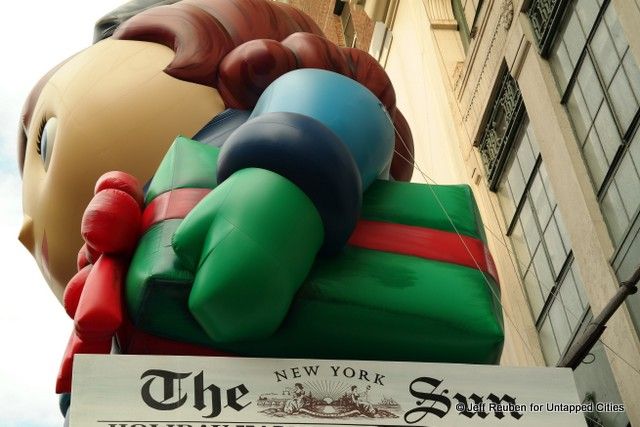
Macy’s Herald Square, December, 2015
Given that it is Christmastime, we start appropriately enough with the New York Sun. The Sun is best remembered for its 1897 editorial “Yes Virginia, There is a Santa Claus,” written in response to a letter to the editor from 8-year old Virginia O’Hanlon. It has been called the most famous newspaper editorial ever, and because of it the Sun has an enduring connection to Christmas. Macy’s Herald Square flagship prominently features the Sun’s logo in its holiday displays.
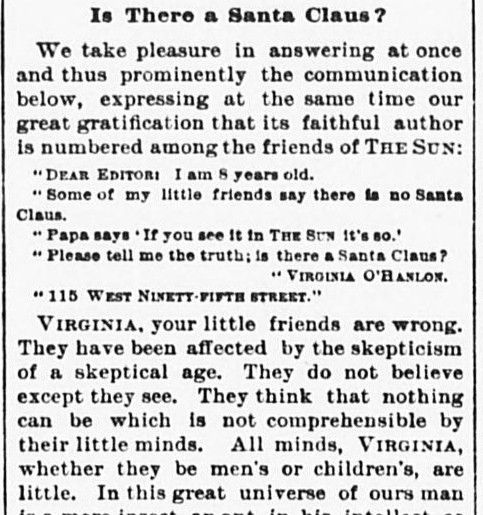
“Is There a Santa Claus” (excerpt). NY Sun, September 21, 1897
Incidentally, the editorial was published on September 21st, indicating that Virginia was already thinking about Christmas long before Santa’s expected arrival.
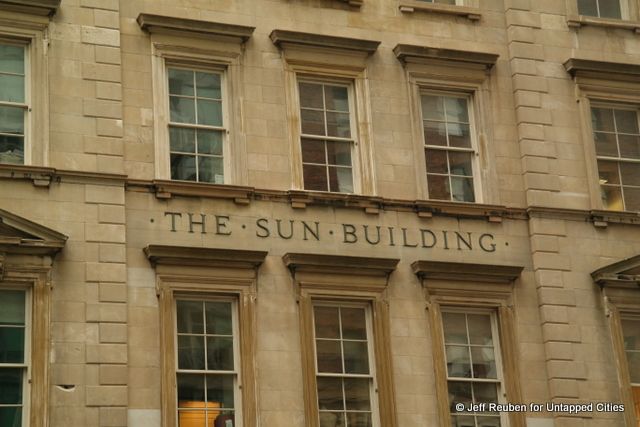
The Sun Building, 280 Broadway (2015)
In 1919 the Sun moved to 280 Broadway, an 1846 building that originally housed the A.T. Stewart dry goods emporium.
The Sun’s former headquarters is still called the Sun Building and features a large clock and thermometer projecting from the facade. It is inscribed with the paper’s name and motto: “It Shines for All.” The Sun Building is now home to New York City government offices.
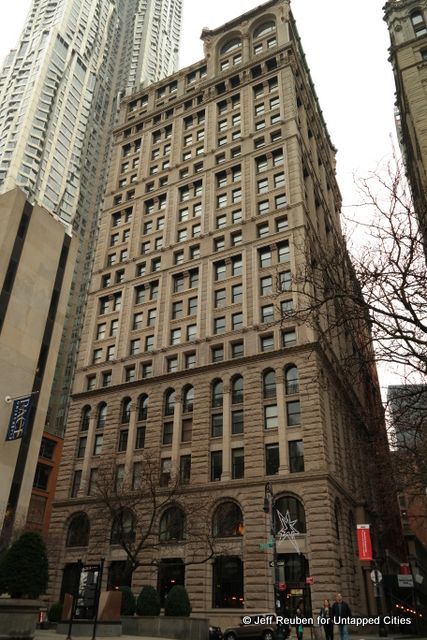
Former Sun Building, 150 Nassau Street (2015)
Before 280 Broadway, from 1914 to 1919 the Sun was located at 150 Nassau Street, which was originally the American Tract Society Building, and was known as the Sun Building while the newspaper was based there.
The Sun Building at 150 Nassau Street, which is now a residential condo, does not have any outward reminders of its newspaper connection but it is notable for being located at the former site of Printing House Square, a newspaper district that existed during the 1800s and early 1900s. The area included several skyscrapers built by newspapers like the New York World and the New York Herald, along Park Row.
The only remaining newspaper building on Park Row is the former New York Times tower. The others are gone, as is the Post Office across the street which distributed New York’s papers across the country.

The skyscrapers of Newspaper Row.New York Times photo archive, Image in public domain from Wikimedia Commons.
The Sun, which stopped publishing in 1950 (when it merged with the World-Telegram), was revived in 2002 and published until 2008 in a nearby building at 105 Chamber Street. One of its writers was Untapped Cities contributor Julia Vitullo-Martin. The Sun continues as a news website.
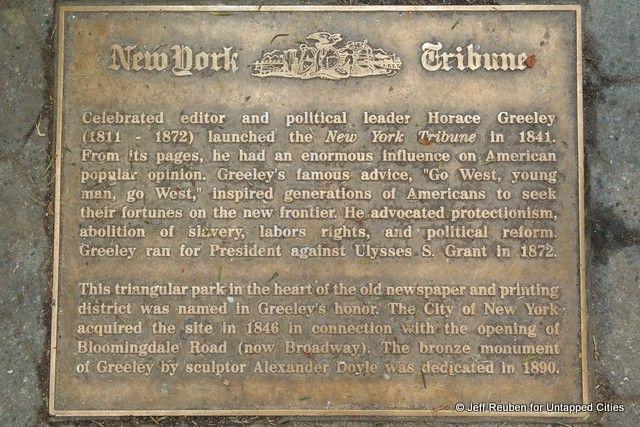
Architecturally the New York Tribune is best remembered for the Tribune Tower, one of the monumental newspaper buildings along Park Row. Although that building was demolished in 1966, the Tribune retains a presence in Midtown.
During the mid 1800s, Tribune founder Horace Greeley famously exhorted “Go west, young man.” In 1894, when the City decided to create a “Greeley Square” in his honor, it ignored his advice and went uptown instead, naming the triangular park bounded by 32nd Street, Sixth Avenue, and Broadway, for him.
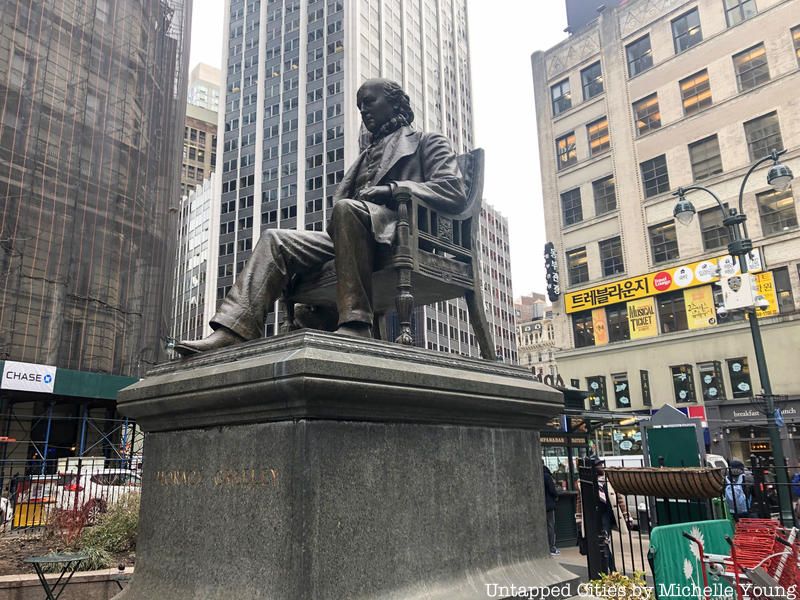
Greeley Square features a statue of Greeley and also has an in-ground historical marker commemorating the New York Tribune. However, most of the time the marker is little noticed as it is usually covered by seating and tables. Although the Tribune never moved its headquarters to Greeley Square, in the late 1800s its “Uptown Office” was located at 1242 Broadway, one block to the south at 31st Street.
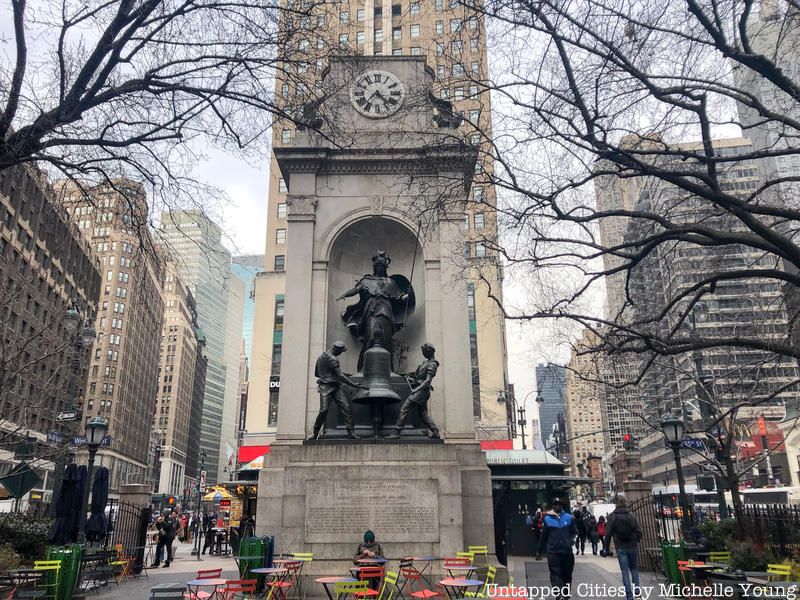
Ironically, the City’s designation of Greeley Square in 1894 followed a path blazed by Greeley’s long-time competitor, the New York Herald. The Herald moved to 35th Street between Broadway and Sixth Avenue in 1893 and the triangular park facing the Herald’s new building was renamed Herald Square, a name adopted for the surrounding area as well.

Owl at the South Entrance to Herald Square Park
As we’ve noted in our recent look at the secrets of Herald Square, although the Herald building was demolished in two stages in 1928 and 1940, adornments from its facade including statues and owls, are incorporated into Herald Square Park.

The New York Herald Building in 1895. Image via Library of Congress.

Former Herald Tribune Building, NY Times Building in the Background (2015)
After decades of rivalry, in 1924 the Herald and Tribune merged to create the New York Herald Tribune. The Herald Tribune, which competed against the New York Times, ceased publication in 1966, though its Paris-based edition continued until 2013, when it became the International New York Times.
The Herald Tribune was based at a building variously known as 230 West 41st Street and 225 West 40th Street, near Times Square. The building is still rich with journalistic connections. Now known as 219 West 40th Street, it is home to the CUNY Graduate School of Journalism and is located next door to the current New York Times building. There is a fantastic collection of 15 vintage typewriters on display inside, a gift from the family of Robert E. Dallos, the New York Bureau Chief of the Los Angeles Timesfrom 1978 to 1991.
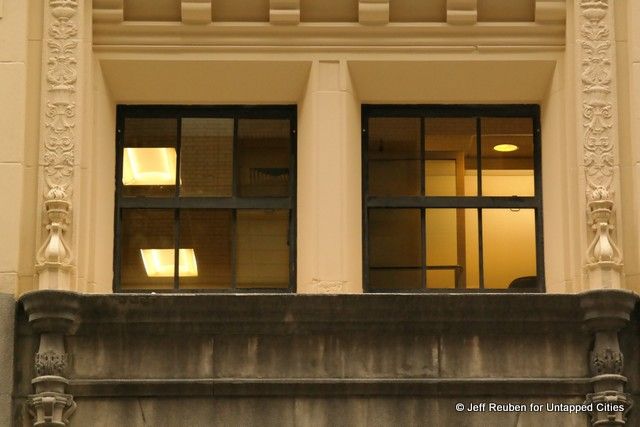
The old Herald Tribune building has a frame above the entrance on 41st Street, covered with what appears to be years of grime. A close look seems to show some very faded lettering. Is this a remnant from the paper’s past?

Former Evening Post Building, 20 Vesey Street (2015)
Some may quibble with the inclusion of the Evening Post on this list of lost newspapers. The Evening Post never went out of business, but is now the New York Post. However, the paper has changed from an evening broadsheet with a generally liberal outlook to a morning tabloid with a conservative viewpoint. The old Evening Post is no more.
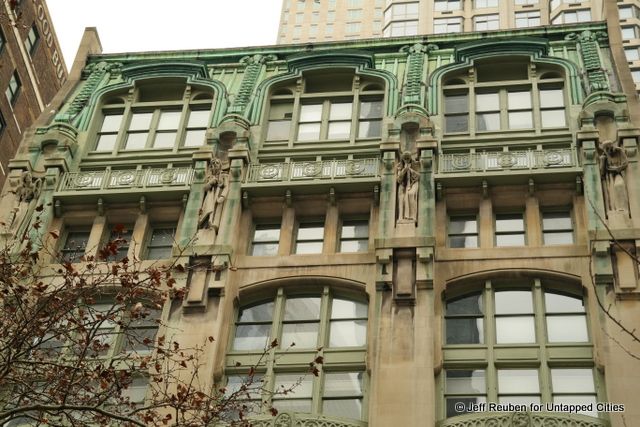
In 1907 the Evening Post constructed a new Art Nouveau style building at 20 Vesey Street, about a block west of Printing House Square. It is now occupied by offices and the 9/11 Memorial Preview Site. The Evening Post left in 1926 and although there are no explicit indications of the building’s newspaper past, the architectural details provide subtle clues.
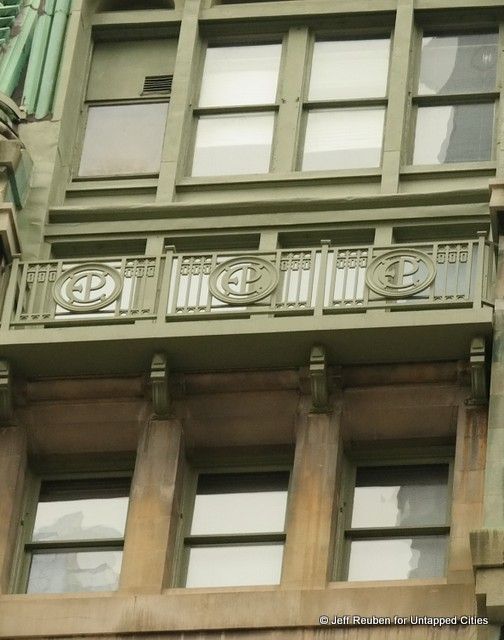
The letters “EP,” for Evening Post, are incorporated into the railings below the top floor. Other elements, including statues by Mount Rushmore creator Gutzon Borglum, provide symbolic references to printing and communications.
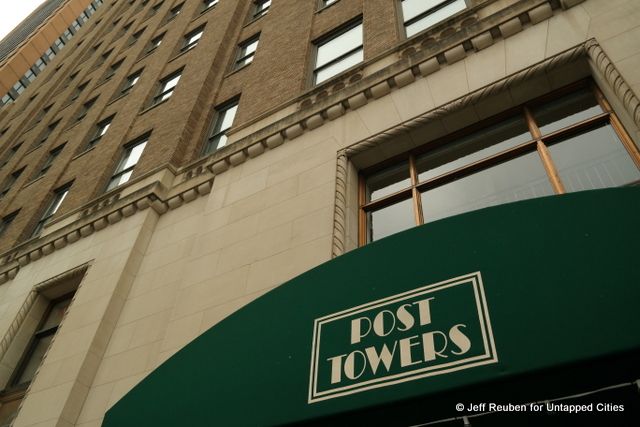
In 1926 the Evening Post moved from 20 Vesey Street to a new building at 75 West Street. It remained in the new Evening Post building until 1967.
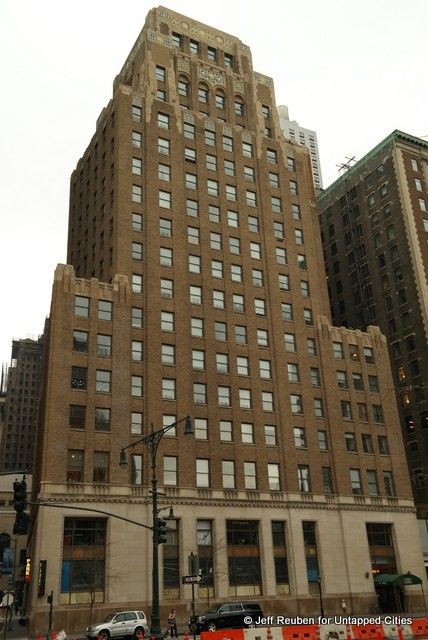
Former Evening Post Building, 75 West Street (2015)
The Art Deco building is now an apartment complex called Post Towers, in a nod to its original occupant.

Former NY Journal-American (Hearst Publications) Building (2015).
In 1927 William Randolph Hearst (the inspiration for Citizen Kane), built a new building for his newspapers the New York American and the Evening Journal. The new facility was located along the East River waterfront on South Street between the Brooklyn and Manhattan bridges, a site well positioned for delivery trucks but far from business areas and subway stations.
Hearst merged the two papers in 1937, creating the New York Journal-American. The hulking building housed the paper until it closed in 1966. The following year the Post bought the building and moved there from its West Street location, remaining until 1995. Today the building is a mini-storage facility but it looks little changed from historic photographs.
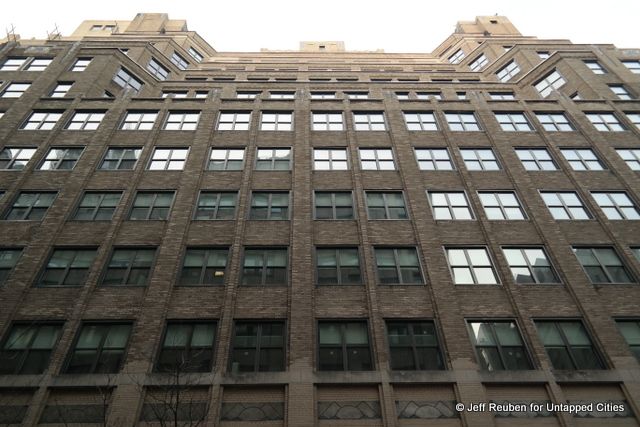
Former Daily Mirror Building, now A&E Networks (2015)
The Daily Mirror, another Hearst newspaper, was a tabloid that competed against the Daily News. It ceased operations in 1963.
The Daily Mirror building at 235 East 45th Street was completed in 1929 and still stands. The headquarters were at 55 Frankfort Street before that Although there is no indication of its newspaper past, it is owned by Hearst Communications and is now occupied by one of its media companies, A&E Networks.
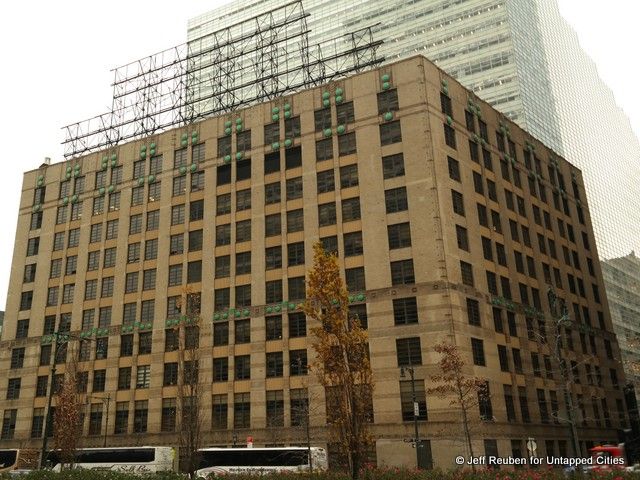
Former World-Telegram Building, now DC 37 Headquarters (2015)
Q: Why does the building at 125 Barclay Street, facing West Street, have a large metal structure on its roof?
A: It is a vestige from the building’s origin as the headquarters of the New York World-Telegram.
The World-Telegram developed this building in 1932, relocating from Telegram Square (previously known as Globe Square). The building prominently featured a sign with the letters “World Telegram” on the aforementioned metal structure, also called an armature.
The undated photo above shows the World-Telegram building with the sign, before the construction of the World Trade Center (to the right) and Battery Park City (in the foreground).
In 1950, the Sun was merged into the paper and it was renamed the World Telegram and Sun.
Following a newspaper strike in 1966, the World-Telegram and Sun closed as did the Herald Tribune and Journal-American. The three closing papers banded together to create a new merged paper, the New York World Journal Tribune, which was based at the old World-Telegram building. The new paper also failed, closing in 1967 and ending a chapter in New York newspaper history.
Today, the old World Telegram building is occupied by District Council 37, a municipal employees union.
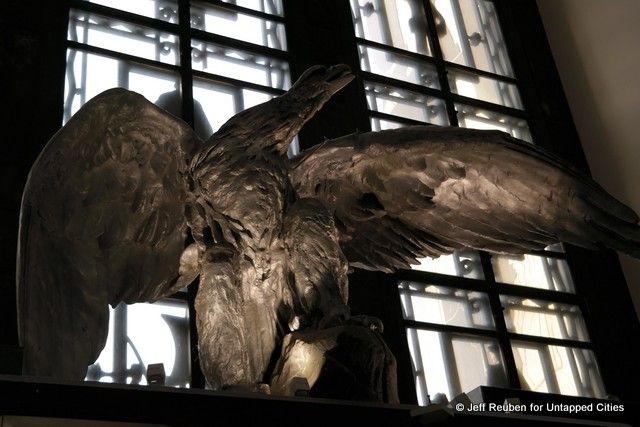
Eagle Sculpture from former Brooklyn Daily Eagle Building, Brooklyn Public Library
The Brooklyn Daily Eagle served as the paper of record for Kings County from 1841 to 1955. Its building at Washington and Johnson streets no long stands, but an eagle sculpture that stood at the top of the building is now perched inside the Brooklyn Public Library’s Central Library, just above the entryway.
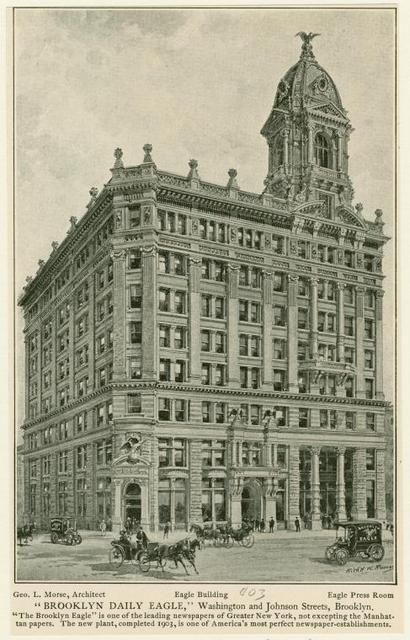
Brooklyn Daily Eagle. Illustration 1903. Via NY Public Library Digital Collections
The Brooklyn Public Library also houses the Eagle’s “morgue,” the archive of the papers’ printed copies. The archives are also available as a free, searchable website. There is a new Eagle currently publishing in Brooklyn as well.

The two first headquarters for the New York Times were actually on Nassau Street – 113 Nassau Street and then 138 Nassau Street. Then, in 1858 the New York Times built a 5-story building a 41 Park Row, along Newspaper Row (pictured above), sharing the building with the American Newspaper Advertising Agency and a patent office. This building would be demolished just thirty years later, and replaced by the 13-story building that still stands there today as part of Pace University. The paper famously moved to 42nd Street in 1904.
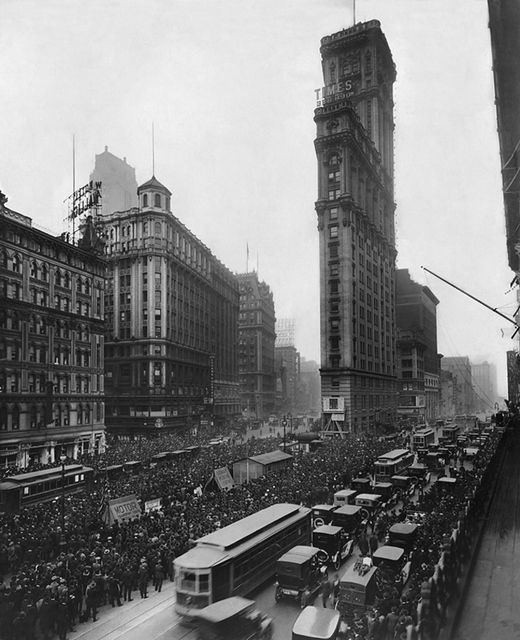
The New York Times moved to Long Acre Square on December 31, 1903, celebrating the occasion with fireworks, now the annual New Year’s Eve tradition with the New Year’s Eve ball introduced in 1908. The narrow building at 42nd Street between Broadway and 7th Avenue, now known as One Times Square, was the newspaper’s headquarters until 1913, when the New York Times built a new annex at West 43rd Street. One Times Square itself was built atop the site of the former Pabst Hotel.
The original facade of One Times Square was granite and terra-cotta but it was reclad in marble in the 1960s. In 1995 Lehman Brothers bought One Times Square for $27.5 million to retrofit as an advertising billboard instead of office space. The wildly profitable building was worth $495 million in 2012 despite being virtually empty on its upper floors. Today the New Year’s Eve ball is stored at the top of the building.
The New York Times moved to its latest headquarters at 620 Eighth Avenue in 2007.
[The above entry excerpted from the book Broadway, by Untapped Cities founder Michelle Young]
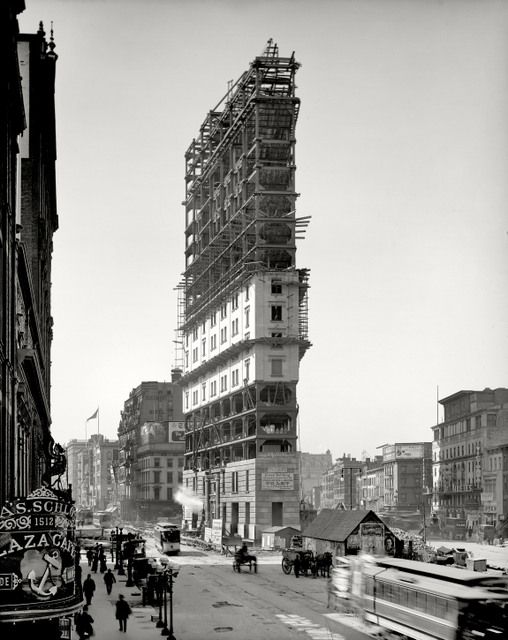
Next, read about newspaper row, the secrets of Herald Square, and the Secrets of Times Square. Contact the author @Jeff_Reuben
Subscribe to our newsletter